|
Journal |
Temple of Anahita in Bishapur
Where do I find the Fire
Altar of this temple? |
|
Series:
Visual Essays Author:
Jamshid Varza
(Slide
Show) |
The
road to Bishapur.
On a beautiful spring day in 1999, I set out to visit the site of Bishapur, the ancient city built by Shapur I, Sassanian Emperor in
celebration of his victory over his Roman adversaries. From Shiraz, the capital of Fars
(Pars) province, it took me about two hours drive on the west bound highway
to reach Bishapur site. This road passed by a beautiful and shallow lake
called Parishan, fed by a small water fall. The latter part of the road
went through several passes where mountain was covered by oak trees, an
unusual and rare scene in Iranian landscape. Where the road sign indicated
fifteen kilometers to the town of Kazerun the ruins of a majestic ancient
site became visible; this was the site of Bishapur "the beautiful city of
Shapur." Air was filled with orange blossom fragrance from a nearby orchard
-- a fine product of the Fars region.
|
|
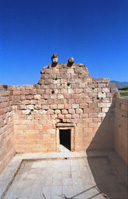
General view |
Shapur river and Chogan pass.
In this location the river Shapur flows through the pass known as "Tang-e
Chogan"; the river Shapur continues its flow through Bishapur and further westward. The
large city walls and gate take us inside the site where Shapur's palace
and temple complex are the focal points. Near the palace complex stairs take us down
to the floor of a temple known as Anahita "the guardian angle of waters in
Zarathushti religion." The structure of this fire temple has remained
relatively untouched, for being covered by several feet of dirt till 1940s
when French archeologist Roman Ghirshman excavated the site of Bishapur.
Where do I find the Fire Altar of this temple?
As I walked around this palace and temple complex, a question came to my
mind -- "Where do I find the Fire Altar of this temple?"
Sassanian Zarathushti kings held high regards for fire temples and
maintained continuous burning fires in their altars. |
|

Stairs from main floor |
Romans settled in Persia.
In order to learn more about this site, I searched for a source of
information from Sassanian era. The most important document relating to this
subject is Shapur's inscription on eastern wall of the fire temple known as Ka'beh Zarathushtra in Naqsh-e
Rostam near Persepolis. This rock carving depicts Shahpur's victory over
three Roman Emperors -- Gordian III, Phillip and Valerian. This is the most important
document from Shapur's reign, 241AD - 272AD, reveals some details of Shahpur's victory which he captured
emperor
Valerian alive and a large number of his soldiers (estimated 70,000), settled
in various regions of Shapur's empire.
A number of findings from this site indicate Sassanian designs and patterns
built using Roman techniques. It is believed that a group of these
Romans were artisans and builders were employed in
building the site of Bishapur. This could explain the Roman influence at Bishapur
buildings. |
|
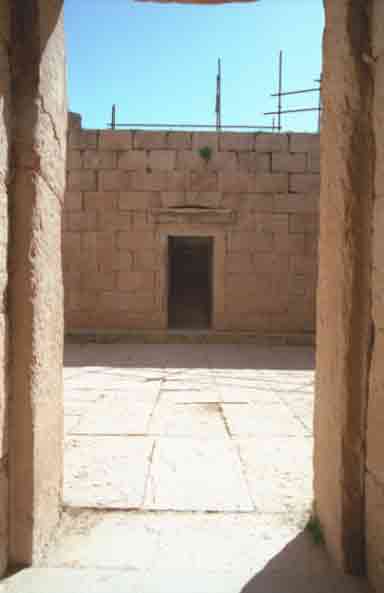
Floor view from entry |
The Palace and Temple Complex.
The floor plan of this complex is shown below. The main entry to the
temple is stairway in front of palace. The plan shows water from river
Shapur is channeled into an under ground canal directed to the temple floor.
The flow of water then continues to feed the town of Bishapur next to the
complex.
(I shall write a future report on palace and other structures found in
Bishapur.) |
|
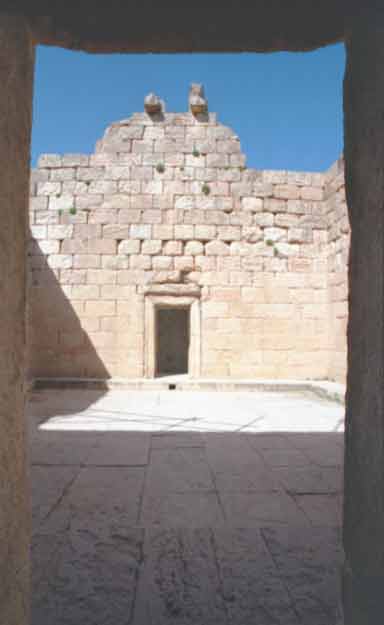
Main wall from floor view |
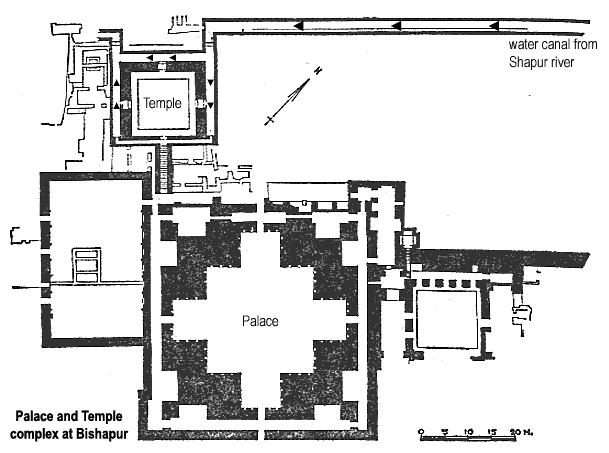 |
|
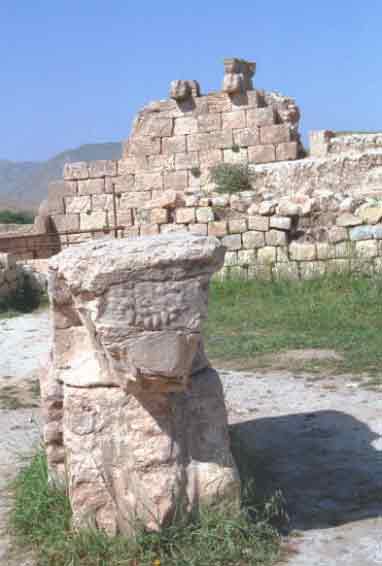
Bull shaped head stone |
Acheamenian style in Sassanian monuments.
Sassanian kings believed to be from Achaemenian lineage, descendents of
Cyrus the great who built and ruled the Persian Empire from 550BC - 330BC.
Several documents from Ardeshir I, Shapur I and Shapur II clearly indicated
this belief. Sassanian monuments used patterns and styles from Achaemenian
monuments found in their homeland of Pars.
The bull shaped head stone on the fire temple is one example of Achaemenian
style similar to Persepolis. The head stones were used to hold the wooden
roof structure of the temple. The carving style of the bull head stone is
quite similar to the column heads found in Persepolis. |
|
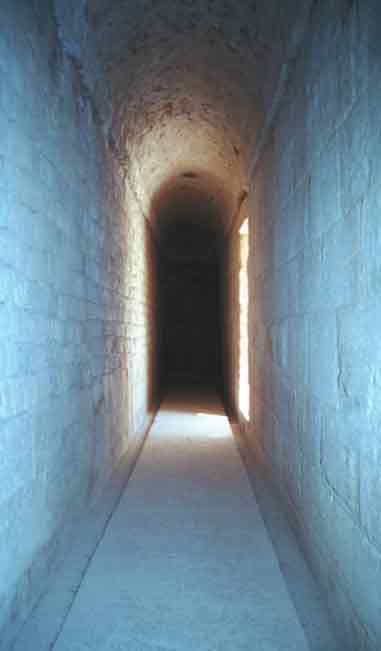
Water canal access |
Water Canals.
Water was directed from Shapur river using under ground water canals to the
floor of the temple. As I looked around the temple floor to find remnants of
the fire altar stone, I saw the ending points of the canals. They were built
be stone and covered with stucco, a technique used in Roman building at the
time. |
|

Water canal access |
My search in the area
did not end in locating the fire altar of the temple. I wasn't ready to give
up on the idea that the altar did not exist or could not be found.
I returned home and several months passed by till I set out to write this
visual essay during November 2001. While working on this essay, the thought
of finding the fire altar returned to my mind. This time my only tools were
books and I was half the world away from this historic monument of Shapur I. |
|
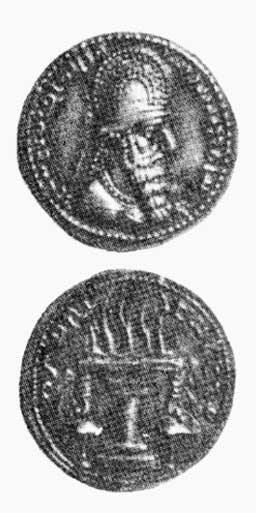
Ardeshir I, coin |
Sassanian Coins.
I was reading through the "Cambridge History of Iran, Vol. 3(1), p.337"
where I saw pictures of several Sassanian coins from Ardeshir I and Shapur I
era.
Sassanian coins are quite accurately identified and catalogued to give us an
identification tool for each Sassanian king. From this source I could
identify few coins from Ardeshir and Shapur all depicting king's profile on
front and fire altar on the back. Perhaps this can be the proof to the
importance of fire temples and altars to Sassanian kings.
From these coins I could figure what the shape of fire altar stone could
have been.
The first coin:
Ardeshir I (224AD - 241AD) Drachma; 1st crown. |
|
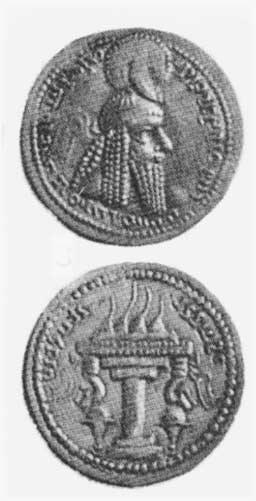
Ardeshir I, coin |
The second coin:
Ardeshir I (224AD - 241AD) Drachma, 2nd crown. |
|
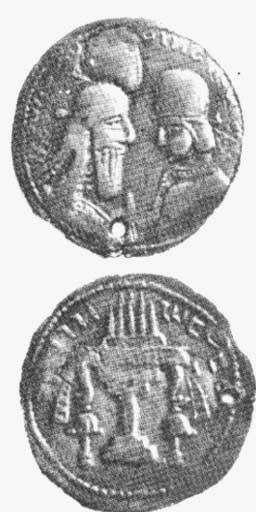
Ardeshir I and Shapur coin |
The third coin:
Ardeshir I (224AD - 241AD) Drachma, with his son
Shapur I. |
|
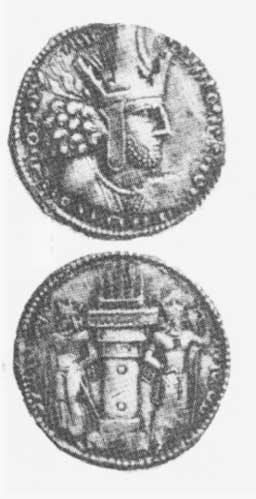
Shapur I, coin |
Fourth coin:
Shapur I. (241AD - 272AD) Drachma, 1st crown. |
|
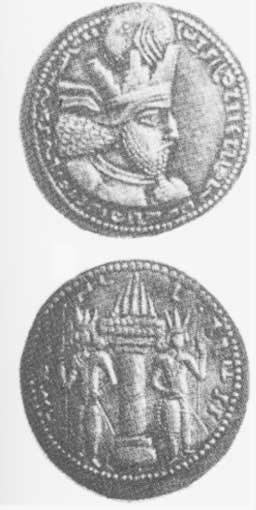
Shapur I, coin |
Fifth coin:
Shapur I. (241AD - 272AD) Drachma, 1st crown.
All the coins from this era showed
the image of the fire altar to be a base stone, small column and the fire
table. My search took me to my last source, the Ghirshman's
archeological book published 1962 "Persian Art, 249AD - 261AD." In
his book Ghishman provides an elaborate record of his archeological
excavation projects in Iranian sites including Bishapur. He provides
numerous photos alongside of his descriptions. I must say this rare book is
quite a feast for an enthusiastic student of Iranian archeology like myself. |
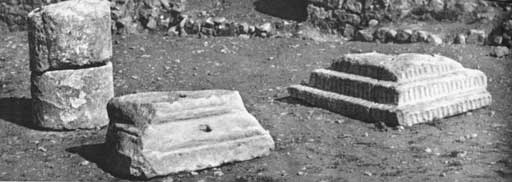
A pleasant surprise.
As I was reading the chapter "Sassanian Art: Architecture and
Monumental Decoration, Rock sculptures" I reached pages on Bishapur site on
pages 149 and later. The picture on page 151 was clearly that of a fire
altar stone similar to images on Sassanian coins. The text below it explained the
stone was buried in the wall of a structure build on the ruins of Bishapur
which was recovered by Roman Ghirshman. A pleasant surprise, I told myself
while finishing this article my search for fire altar stone reached is
positive result. |